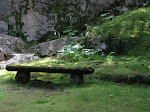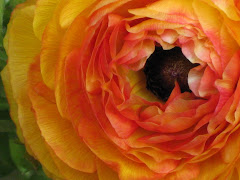 The azaleas have been in bloom in Washington the past few weeks. While I adore azaleas spread throughout a woodland garden, there are some yards that have gone a little overkill with these ubiquitous foundation plantings (like mine). I inherited a somewhat mature garden, with, no joke, over 50 different varieties or cultivars of azaleas, which in bloom, looks much like "flower vomit."
The azaleas have been in bloom in Washington the past few weeks. While I adore azaleas spread throughout a woodland garden, there are some yards that have gone a little overkill with these ubiquitous foundation plantings (like mine). I inherited a somewhat mature garden, with, no joke, over 50 different varieties or cultivars of azaleas, which in bloom, looks much like "flower vomit."As a young child, I nicknamed my room "the flower vomit room." It had been decorated for my two older sisters, circa 1968. Painted pale pink, it had (according to my mother) very expensive 100% wool bright pink carpet that wouldn't show wear for at least 25 years (and it didn't). But my least favorite part (and no offense to the unnamed decorator), the bed linens and curtains were a blend of pinks and chartreuse and olive green, somewhat modern at that time, and to not appear overly floral for young pre-adolescent girls. It was quite out-of-style when my sisters went to college and I got my own room for the first time. I loved having my own space and not having to share a room with my rough and tumble younger brothers, but I was a tomboy through and through. Pink and I just clashed.
Pink and I still clash. My personality is much more blue, yellow and green mixed with a little dirt, er, brown. Somedays I might be a bit more red, but only if the aphids are eating my roses or my dear dog buries a bone where I've just planted dahlia bulbs. Pink is pretty and kind and gentle and delicate. In the garden, I like pink limited quantities, over there in the distance for a spot of color, or set against the backdrop of lots and lots of dark green foliage.
So my dilemna remains what to do with the wash of pink that blankets my garden for three weeks in April and May, then nothing for the remaining 11 months of the year?
Over time, a few have died giving me the chance to fill in with new deciduous shrubs with varying textures and bloom times, such as Hydrangea quercifolia, Oakleaf Hydrangea and Viburnum plicatum var. tomentosum, Doublefile Viburnum. The shady conditions and and mature height of the azaleas has offered space to experiment with shade perennial combinations -- last spring I mixed Polygonatum odoratum 'Variegatum', Solomon's Seal, Athyrium niponicum var. pictum, Japanese Painted Fern, Heuchera x 'Plum Puddin', Plum Puddin Coralbells, and Carex comans, Hair Sedge.
So, yes, I will continue to endure and appreciate the flower vomit each spring, if only as a launching point for experimentation.



Rita took most of my azaleas..which were all over my yard, I am happy to say(and dissappointed your mom to no end.) I kind of got a fresh start with my yard..but She loved them..she told me they were years and years old and would take forever to get any that large again. I wasn't a tomboy but I am more like you! Blue and green and I also love yellow! I really have never been a pink fan (much to my mothers dismay) I just prefer more natural colors. My yard is my project this year...so any advice on good filler for beds that tends to take over would be greatly appreciated!
ReplyDeleteMonica's Mom has this amazing hydrangea Plant that nearly is as large as the left side of her house..Bea told me that to get them blue she sticks nails in the ground...how does that work?
ReplyDeleteNot to dismiss Monica's mom, but that is an old wives' tale.
ReplyDeleteAn acid soil allows a higher concentration of aluminum within the soil which is the factor that affects the blue color of hydrangeas (the higher concentration of aluminum in the soil, the deeper the blue color). Adding aluminum to the soil (most often aluminum sulfate) can help hydrangeas turn more blue, but really it's the acidity (or alkalinity) of the soil that impacts the color. This would be added in the winter while the plant is dormant to impact the plant in the following spring/summer.
While she may be putting aluminum nails in with her hydrangeas, more than likely she already has acidic soil and it would be blue anyway. It would take many, many nails to leach enough aluminum into the soil to really affect the soil composition. Check to see if she also has some pine trees and azaleas, more than likely she has acidic soil.
Also, there are a number of cultivars that are deeply blue, even in soil that is not so acidic, such as 'Nikko's Blue', an older cultivar that is commonly sold at nurseries.
If you want a more pink shade, then lime applications in the winter will raise the alkalinity and bring out a more pinkish color flower. Note that if you are making soil amendments to affect flower color, you would need to repeat it every year to maintain the effect.
I am not really a pink garden girl but I do have to say it looks magnificent - if even only for a short time.
ReplyDelete